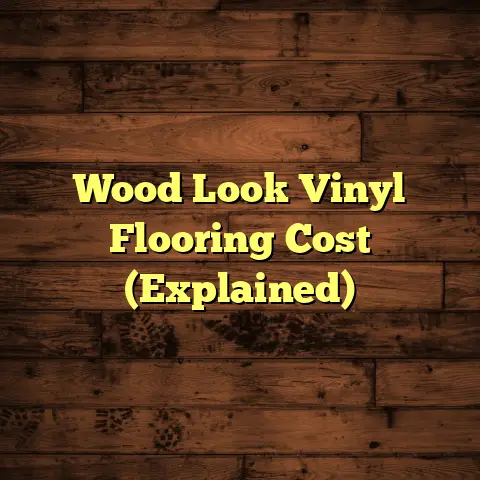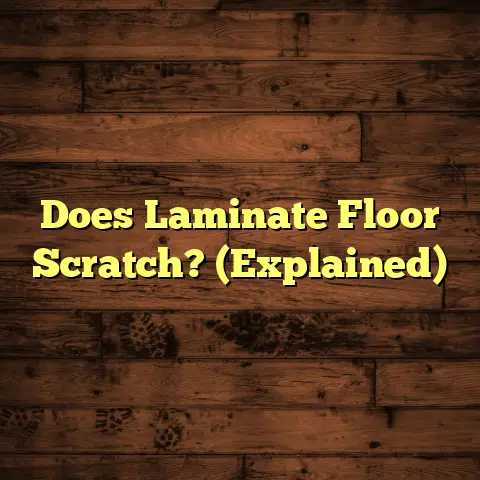Castile Soap On Floors? (5 Damage Risks!)
Imagine walking into a home.
The sunlight streams through large windows, illuminating the gleaming hardwood floors.
Or perhaps it’s the cool, smooth surface of exquisite marble that catches your eye.
Maybe it’s the sleek, modern lines of high-end tile stretching out before you.
These aren’t just floors; they’re statements.
They reflect a homeowner’s investment, their taste, their commitment to quality.
And maintaining that luxurious look?
Well, that’s where things can get tricky.
I’ve seen it all in my years as a flooring contractor.
Homeowners, eager to keep their prized floors spotless, often turn to Castile soap.
It’s natural, it’s eco-friendly, and it seems like a gentle option.
But here’s the thing: Castile soap isn’t always the perfect solution.
In fact, it can pose some serious risks to your high-end flooring.
I’m talking about damage that can dull, stain, or even void your warranty.
So, before you reach for that bottle of Castile soap, let’s dive into the potential pitfalls and how to avoid them.
Ready to learn more? Let’s get started!
Section 1: Understanding Castile Soap
Okay, so what exactly is Castile soap?
Think back to its origins.
It traditionally comes from the Castile region of Spain.
It was originally made with olive oil.
Today, it’s generally made with vegetable oils.
These include coconut, palm, or hemp.
It’s biodegradable, free of synthetic additives, and often packaged sustainably.
No wonder it’s a favorite among eco-conscious consumers.
It’s incredibly versatile too!
You can use it for everything from washing your face to cleaning your countertops.
But why are luxury homeowners drawn to it?
Well, the appeal is understandable.
It promises a gentle, natural clean.
It aligns with a desire for sustainability.
Plus, many believe natural means safe.
However, when it comes to luxury flooring, that assumption can be risky.
The high oil content in Castile soap, while great for moisturizing skin, can cause issues on certain floor surfaces.
So, are you starting to see the potential conflict between Castile soap’s benefits and the specific needs of luxury flooring?
Section 2: The Allure of Luxury Flooring
Let’s talk about luxury flooring.
What comes to mind when you hear that term?
For me, it’s the rich, warm tones of perfectly installed hardwood.
It could be the timeless elegance of marble, with its unique veining and polished surface.
Or perhaps it’s the resilient beauty of luxury vinyl, designed to mimic natural materials without the hefty price tag.
These flooring options aren’t just about aesthetics.
They represent a significant investment in your home’s value and overall ambiance.
According to the National Association of Realtors, homes with hardwood floors tend to sell for higher prices and faster than those without. (Source: nar.realtor)
Luxury vinyl is also gaining popularity for its durability and water resistance, making it a smart choice for high-traffic areas.
But here’s the key: to retain their beauty and value, luxury floors require proper maintenance.
I often consult with interior designers who emphasize the importance of choosing the right cleaning products for different flooring types.
“You wouldn’t use the same shampoo on your hair as you would on your dog, right?”
One designer told me recently.
“Flooring is the same! Each material has its own unique needs.”
And that’s where the potential problems with Castile soap start to surface.
Are you thinking about your own floors now, and what they need to stay in top shape?
Section 3: Risk #1 – Residue Buildup
Alright, let’s get into the first big risk: residue buildup.
Castile soap, despite its cleaning power, has a tendency to leave behind a film, especially if it’s not rinsed thoroughly.
This residue is due to the soap’s high fatty acid content, which can react with minerals in hard water, forming soap scum.
Imagine your gleaming hardwood floors slowly becoming dull and cloudy.
That’s the impact of residue buildup.
It’s particularly problematic on flooring types like hardwood, tile, and even some types of luxury vinyl.
The long-term effects can be even worse.
Residue can trap dirt and grime, making your floors look perpetually dirty.
It can also attract more dust, creating a vicious cycle of cleaning and buildup.
I’ve seen homeowners spend countless hours trying to scrub away this residue, often using harsh chemicals that can further damage their floors.
One client of mine had beautiful, dark hardwood floors that had become noticeably hazy over time.
She had been using Castile soap, thinking she was doing the right thing.
It took a professional cleaning and re-sealing to restore the floors to their original luster.
So, are you checking your floors for any signs of dullness or cloudiness?
It might be the first sign of residue buildup.
Section 4: Risk #2 – Slippery Surfaces
Now, let’s talk about something that can be downright dangerous: slippery surfaces.
The use of Castile soap can create a dangerously slick floor, especially on materials like tile and polished hardwood.
Think about it: you’re applying a soapy solution to a surface that’s designed to be walked on.
If the soap isn’t rinsed away completely, it can leave behind a residue that reduces traction and increases the risk of slips and falls.
I’ve heard countless stories of accidents caused by slippery floors, ranging from minor bumps and bruises to serious injuries.
One homeowner I know slipped on her newly cleaned tile floor and broke her wrist.
It was a painful reminder of the importance of maintaining traction, especially in homes with children or elderly residents.
According to the National Safety Council, falls are a leading cause of injury in the home, and slippery floors are a major contributing factor. (Source: nsc.org)
Maintaining traction on luxury flooring is crucial for safety and peace of mind.
I always advise my clients to test any new cleaning product in an inconspicuous area before applying it to the entire floor.
And if you’re using Castile soap, be sure to rinse thoroughly with clean water to remove any residue.
Are you now considering how slippery your floors might be after cleaning?
It’s a safety concern that’s often overlooked.
Section 5: Risk #3 – Chemical Reactions
Let’s move on to another potential danger: chemical reactions.
Mixing Castile soap with certain substances, like vinegar or ammonia, can lead to hazardous reactions, potentially damaging your luxury flooring materials.
Castile soap is alkaline, meaning it has a high pH level.
When you mix it with an acidic substance like vinegar, it can create an unstable solution that can strip away finishes and damage the surface of your floors.
Ammonia, on the other hand, can react with the oils in Castile soap to produce toxic fumes.
I’ve seen homeowners inadvertently create these reactions by following well-intentioned but misguided cleaning advice.
For example, some people recommend adding vinegar to Castile soap to boost its cleaning power.
While this may seem like a good idea, it can actually do more harm than good.
These practices can have serious implications for homeowners who may not be aware of the risks.
It’s important to remember that not all cleaning products are created equal, and mixing them can be dangerous.
I always advise my clients to read the labels carefully and follow the manufacturer’s instructions.
If you’re unsure about whether a particular cleaning product is safe for your floors, it’s always best to err on the side of caution and consult with a professional.
Have you ever mixed cleaning products without knowing the potential risks?
It’s a common mistake that can have costly consequences.
Section 6: Risk #4 – Staining and Discoloration
Now, let’s talk about something that can really ruin the look of your floors: staining and discoloration.
Certain ingredients in Castile soap can react with the finishes on luxury floors, causing unwanted changes in color or texture.
For example, some Castile soaps contain essential oils that can stain porous materials like marble or unfinished hardwood.
The oils can penetrate the surface and leave behind a dark, oily residue that’s difficult to remove.
I’ve seen homeowners try to remove these stains with harsh chemicals, only to make the problem worse.
Different flooring materials react differently to Castile soap.
Hardwood can become discolored or develop a hazy film.
Marble can become etched or stained.
Even luxury vinyl can be affected, with some types becoming dull or sticky.
To prevent these outcomes, it’s important to test Castile soap in an inconspicuous area before applying it to the entire floor.
You should also avoid using Castile soap on flooring materials that are known to be sensitive to oils or alkaline solutions.
If you do choose to use Castile soap, be sure to dilute it properly and rinse thoroughly with clean water.
And always follow the manufacturer’s recommendations for cleaning your specific flooring type.
Are you worried about potential staining or discoloration on your floors?
It’s a valid concern, especially if you’re using a cleaning product that’s not specifically designed for your flooring material.
Section 7: Risk #5 – Warranty Implications
Finally, let’s talk about something that can really hit you in the wallet: warranty implications.
Using Castile soap or other non-recommended cleaning products can void warranties provided by flooring manufacturers.
Most flooring warranties specify the types of cleaning products that are approved for use on the flooring material.
If you use a product that’s not on the approved list, you could void your warranty and be responsible for any damage that occurs.
I’ve seen homeowners lose thousands of dollars because they used the wrong cleaning product and voided their warranty.
It’s a costly mistake that can easily be avoided.
Adhering to manufacturer guidelines for cleaning and maintenance is crucial for protecting your investment.
Read the warranty carefully and follow the recommendations for cleaning and maintaining your floors.
If you’re unsure about whether a particular cleaning product is safe, contact the manufacturer or a flooring professional for advice.
And always keep records of your cleaning products and maintenance practices in case you need to file a warranty claim in the future.
Are you familiar with the warranty requirements for your floors?
It’s important to understand your responsibilities as a homeowner to protect your investment and avoid costly surprises.
Conclusion
So, there you have it: five potential risks associated with using Castile soap on luxury floors.
While Castile soap may be a popular choice for eco-friendly cleaning, it’s not always the best option for high-end flooring materials.
Residue buildup, slippery surfaces, chemical reactions, staining and discoloration, and warranty implications are all potential problems that can arise from using Castile soap improperly.
As a homeowner committed to preserving the beauty and integrity of your floors, it’s crucial to understand these risks and choose the right cleaning solutions for your specific flooring type.
Remember, luxury flooring is an investment.
Protect it by using cleaning products that are specifically designed for your flooring material and following the manufacturer’s recommendations for cleaning and maintenance.
And if you’re ever unsure about whether a particular cleaning product is safe for your floors, don’t hesitate to consult with a flooring professional.
Your floors will thank you for it!





